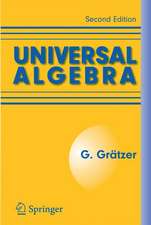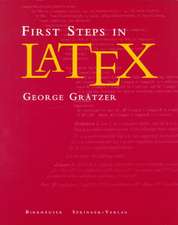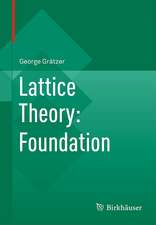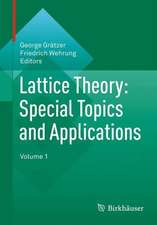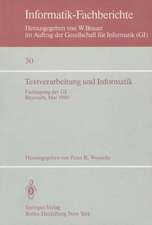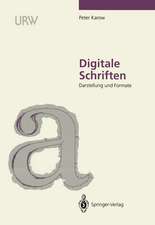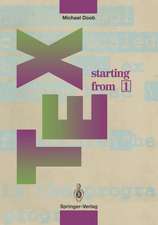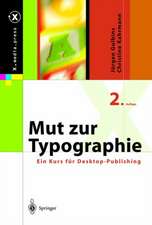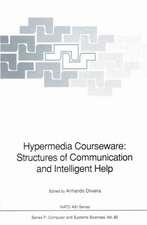Practical LaTeX
Autor George Grätzeren Limba Engleză Paperback – sep 2014
A short chapter, Mission Impossible, introduces LaTeX documents and presentations. Read these 30 pages; you then should be able to compose your own work in LaTeX. The remainder of the book delves deeper into the topics outlined in Mission Impossible while avoiding technical subjects. Chapters on presentations and illustrations are a highlight, as is the introduction of LaTeX on an iPad.
Students, faculty, and professionals in the worlds of mathematics and technology will benefit greatly from this new, practical introduction to LaTeX. George Grätzer, author of More Math into LaTeX (now in its 4th edition) and First Steps in LaTeX, has been a LaTeX guru for over a quarter of century.
From the reviews of More Math into LaTeX:
``There are several LaTeX guides, but this one wins hands down for the elegance of its approach and breadth of coverage.''
—Amazon.com, Best of 2000, Editors Choice
``A very helpful and useful tool for all scientists and engineers.''
—Review of Astronomical Tools
``A novice reader will be able to learn the most essential features of LaTeX sufficient to begin typesetting papers within a few hours of time…An experienced TeX user, on the other hand, will find a systematic and detailed discussion of all LaTeX features, supporting software, and many other advanced technical issues.''
—Reports on Mathematical Physics
Preț: 231.26 lei
Preț vechi: 289.08 lei
-20% Nou
Puncte Express: 347
Preț estimativ în valută:
44.25€ • 46.41$ • 36.84£
44.25€ • 46.41$ • 36.84£
Carte tipărită la comandă
Livrare economică 01-15 aprilie
Preluare comenzi: 021 569.72.76
Specificații
ISBN-13: 9783319064246
ISBN-10: 331906424X
Pagini: 216
Ilustrații: XVI, 216 p. 55 illus., 20 illus. in color. With online files/update.
Dimensiuni: 178 x 254 x 12 mm
Greutate: 0.41 kg
Ediția:2014
Editura: Springer International Publishing
Colecția Springer
Locul publicării:Cham, Switzerland
ISBN-10: 331906424X
Pagini: 216
Ilustrații: XVI, 216 p. 55 illus., 20 illus. in color. With online files/update.
Dimensiuni: 178 x 254 x 12 mm
Greutate: 0.41 kg
Ediția:2014
Editura: Springer International Publishing
Colecția Springer
Locul publicării:Cham, Switzerland
Public țintă
Popular/generalCuprins
Introduction.- 1. Getting LaTex.- 2. Typing Text.- 3. Text environments.- 4. Typing Formulas.- 5. Displayed Formulas.- 6. Articles.- 7. Making Presentations.- 8. Customization.- 9. The Symbol Tables.- Index.
Recenzii
From the book reviews:
“I’ve been looking for a friendly and accessible manual that I could recommend to students as a way to get over the initial learning curve, and this book seemed like it would fit the bill. … The emphasis is on skills necessary for writing and presenting in an academic setting, and in particular it is geared toward students in math, physics, and numerate disciplines. … Overall, it is a well-presented volume and pleasant to read.” (Sara Kalvala, Computing Reviews, December, 2014)
“The book starts with a quick survey, and then explores a bit deeper how to typeset the text, the use of environments, (mathematical) formulas and arrays, and finally the global structure of the document (top matter, body, back matter). … this book might be interesting to read, not only for the beginner, but also for the experienced LaTeX user.” (Adhemar Bultheel, euro-math-soc.eu, December, 2014)
“If I really, really have to learn LaTeX, this is the book I’ll go to in a flash. … Even at a first glance or at first browse it’s abundantly clear that this is a very good book for a TeXtyro like me … . It’s eminently practical and therefore eminently worthwhile.” (Michael Berg, MAA Reviews, November, 2014)
“I’ve been looking for a friendly and accessible manual that I could recommend to students as a way to get over the initial learning curve, and this book seemed like it would fit the bill. … The emphasis is on skills necessary for writing and presenting in an academic setting, and in particular it is geared toward students in math, physics, and numerate disciplines. … Overall, it is a well-presented volume and pleasant to read.” (Sara Kalvala, Computing Reviews, December, 2014)
“The book starts with a quick survey, and then explores a bit deeper how to typeset the text, the use of environments, (mathematical) formulas and arrays, and finally the global structure of the document (top matter, body, back matter). … this book might be interesting to read, not only for the beginner, but also for the experienced LaTeX user.” (Adhemar Bultheel, euro-math-soc.eu, December, 2014)
“If I really, really have to learn LaTeX, this is the book I’ll go to in a flash. … Even at a first glance or at first browse it’s abundantly clear that this is a very good book for a TeXtyro like me … . It’s eminently practical and therefore eminently worthwhile.” (Michael Berg, MAA Reviews, November, 2014)
Notă biografică
George Grätzer is now Emeritus professor from the University of Manitoba. In addition to his best-selling books in LaTeX, Grätzer has proved to be a skilled author of several books such as “Universal Algebra" © Springer 2008 and "General Lattice Theory" © 1998 Birkhäuser. Recently the author has published two useful and important articles in the Notices of the AMS relating to portability of LaTeX.
Textul de pe ultima copertă
Practical LaTeX covers the material that is needed to compose everyday LaTeX documents. This accessible manual is friendly, easy to read, and is designed to be as portable as LaTeX itself.
A short chapter, Mission Impossible, introduces LaTeX documents and presentations. Read these 30 pages; you should then be able to compose your own work in LaTeX. The remainder of the book delves deeper into the topics outlined in Mission Impossible while avoiding technical subjects. Chapters on presentations and illustrations are a highlight, as is the introduction of LaTeX on an iPad.
Students, faculty, and professionals in the worlds of mathematics and technology will benefit greatly from this new, practical introduction to LaTeX. George Grätzer, author of More Math into LaTeX (now in its 4th edition) and First Steps in LaTeX, has been a LaTeX guru for over a quarter of century.
From the reviews of More Math into LaTeX:
``There are several LaTeX guides, but this one wins hands down for the elegance of its approach and breadth of coverage.''
—Amazon.com, Best of 2000, Editors Choice
``A very helpful and useful tool for all scientists and engineers.''
—Review of Astronomical Tools
``A novice reader will be able to learn the most essential features of LaTeX sufficient to begin typesetting papers within a few hours of time…An experienced TeX user, on the other hand, will find a systematic and detailed discussion of all LaTeX features, supporting software, and many other advanced technical issues.''
—Reports on Mathematical Physics
A short chapter, Mission Impossible, introduces LaTeX documents and presentations. Read these 30 pages; you should then be able to compose your own work in LaTeX. The remainder of the book delves deeper into the topics outlined in Mission Impossible while avoiding technical subjects. Chapters on presentations and illustrations are a highlight, as is the introduction of LaTeX on an iPad.
Students, faculty, and professionals in the worlds of mathematics and technology will benefit greatly from this new, practical introduction to LaTeX. George Grätzer, author of More Math into LaTeX (now in its 4th edition) and First Steps in LaTeX, has been a LaTeX guru for over a quarter of century.
From the reviews of More Math into LaTeX:
``There are several LaTeX guides, but this one wins hands down for the elegance of its approach and breadth of coverage.''
—Amazon.com, Best of 2000, Editors Choice
``A very helpful and useful tool for all scientists and engineers.''
—Review of Astronomical Tools
``A novice reader will be able to learn the most essential features of LaTeX sufficient to begin typesetting papers within a few hours of time…An experienced TeX user, on the other hand, will find a systematic and detailed discussion of all LaTeX features, supporting software, and many other advanced technical issues.''
—Reports on Mathematical Physics
Caracteristici
Accessible at 200+ pages to all who want to learn the practical usages of LaTeX Avoids technical subjects like font usage Friendly and easy to read, with many examples included Extra source materials include sample LaTeX files and suggestions for further reading Includes supplementary material: sn.pub/extras


